[:nl]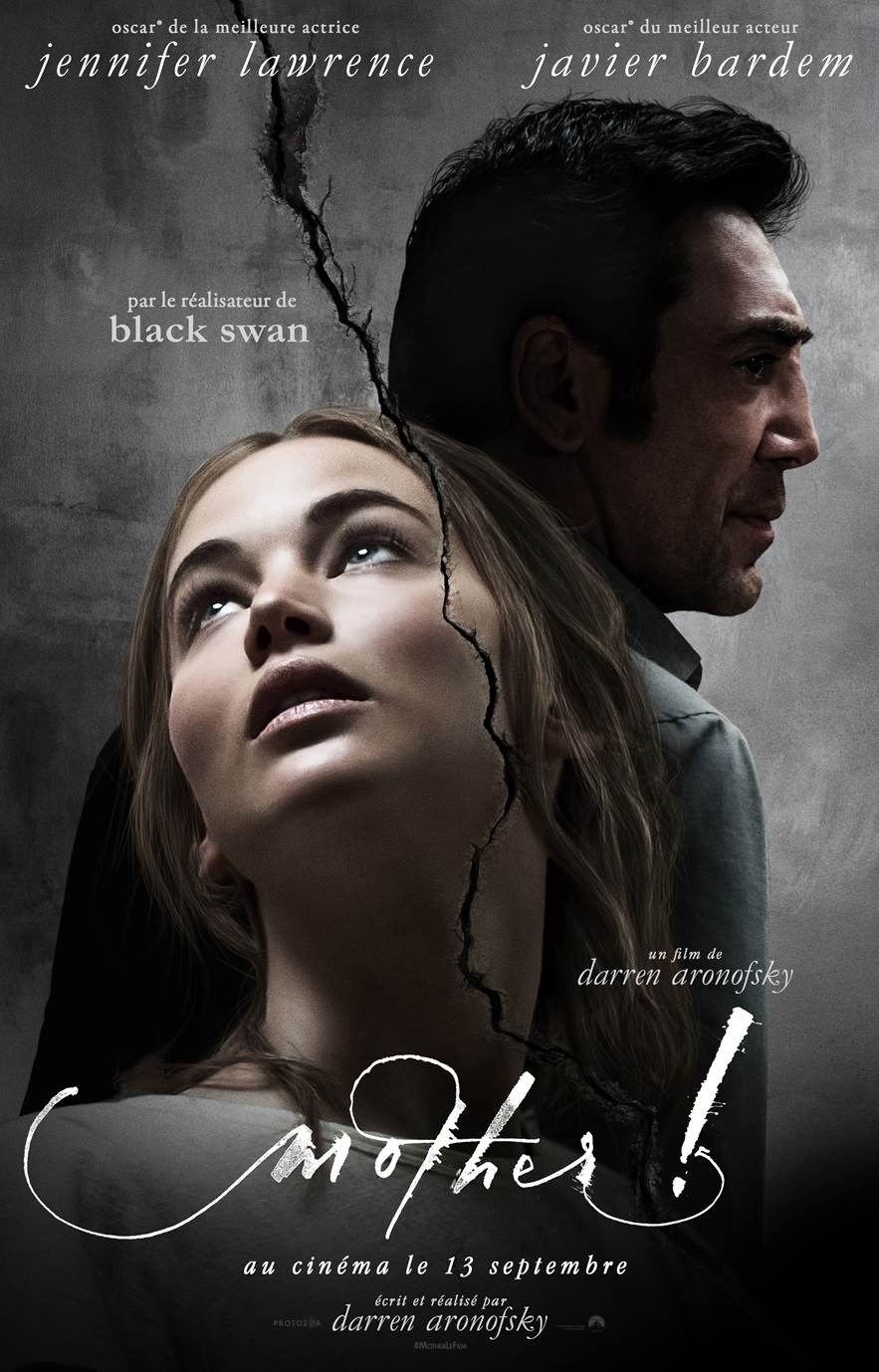
Last tuesday I went to the theater to watch Darren Aronofsky’s mother! again. For those who wonder: nobody forced me to do that. I chose to feel uncomfortable for two more hours, to delve myself deeper into a story that got its hold on me all week long. This is a cinematic nightmare that will divide people for the years to come. It already does: mother! received an F-rating from the American cinema public, but there are many voices proclaiming the very same movie is an absolute masterpiece.
In this analytical essay, I will focus on one specific reading of this movie, that could possibly help to appreciate and understand some of the parts that put this psychological mystery together. In order to do that, I will use the proposotion that mother! can be read as an allegory. This means the ideas and the characters of the movie represent something else. They refer to meaningful concepts and stories that exceed the storyworld itself. The possibility of an allegory brings me to the following statement: Darren Aronofsky’s mother! Is an intriguing religious allegory, in which specific sequences and characters mainly refer to biblical stories, persons and ideas.
The characters
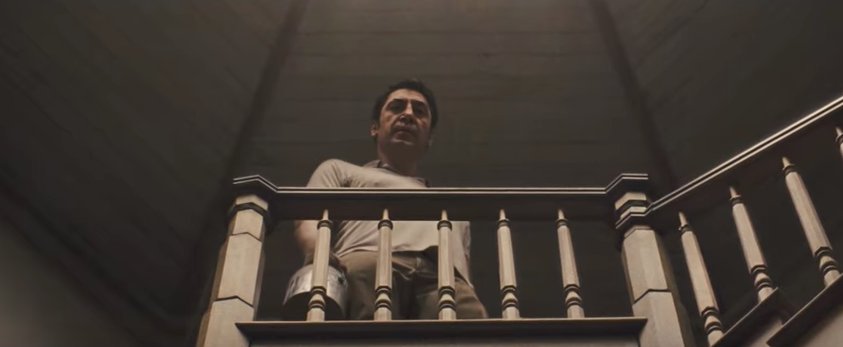
When the movie approached its shocking finale, it became clear to me that the male lead actually represents God. In the very beginning of the film, we see how the concept of creation goes hand in hand with the deeds of Javier Bardems character. After he touches a mysterious glowing stone, the house actually starts to ‘live’. Green vegetation replaces the dust, the darkness and the silence. The house thus awakens, and so does the character called mother (Jennifer Lawrence). The temporality here (creation and awakening go together) is the first clue mother is actually mother earth, or mother nature. I will come back to that observation later.
When you read the biblical book of Genesis, you can notice that the beginning of mother! resembles the process of biblical creation. Both stories elaborate on the possibility of making something out of nothing, using the performative power of a mighty entity. One interesting difference is at stake here: in Genesis, the voice of God is enough to start the process of creation (Genesis 1); in mother!, Javier Bardem needs a mystical stone to bring life into the house. This can be seen as a limitation; the God of mother! needs something else to create, he can’t do it all by himself. This suggestion becomes more solid if you keep in mind that Bardems character turns out to be a poet with a serious writers block. The principle of first creation is followed by hesitation and doubt. What to do, for example, when the people wandering on earth try to kill eachother?
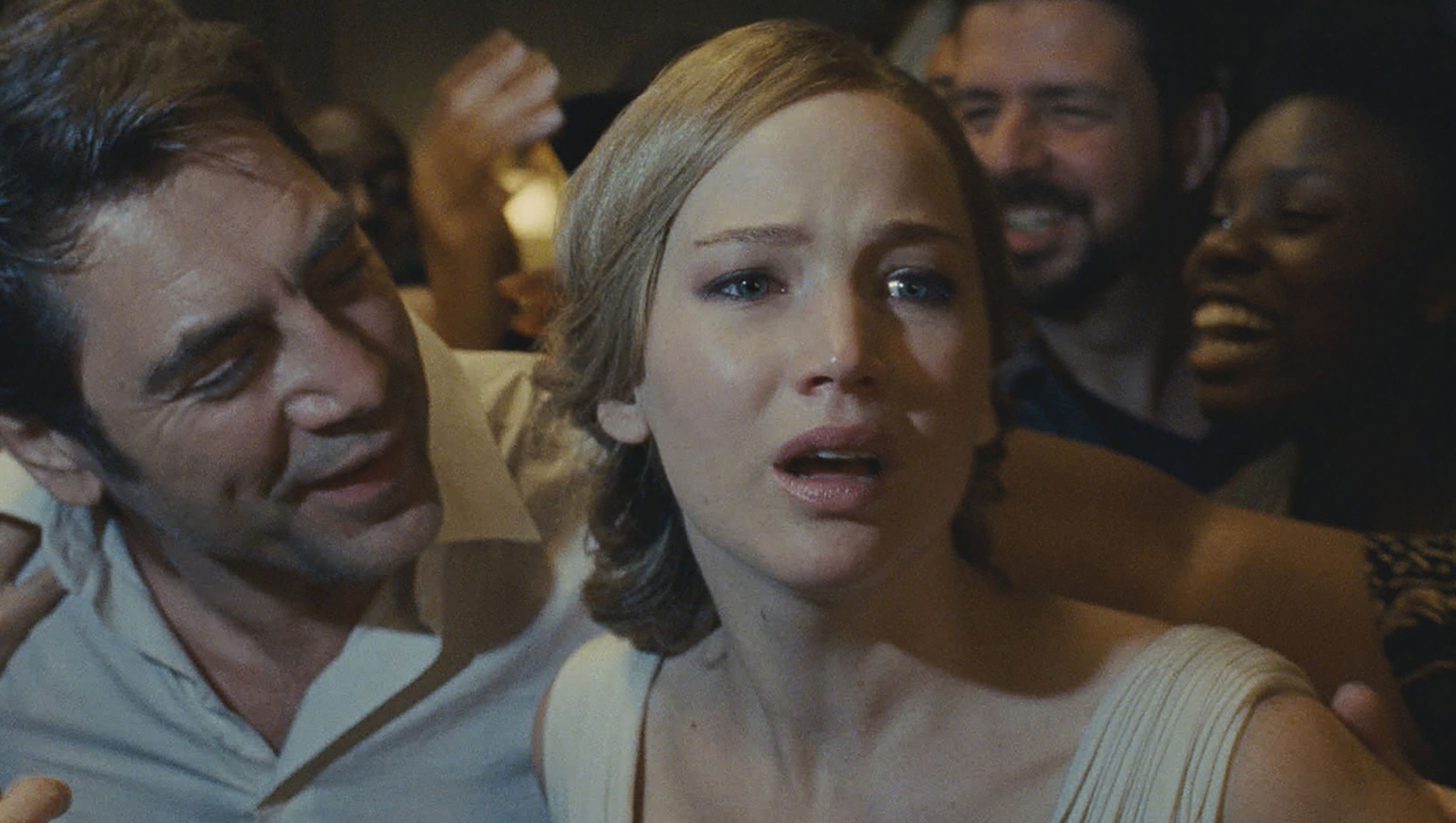
In my opinion, the case for the story of Cain and Abel (Genesis 4) is really strong here. The two sons entering the house are the sons of the first people on earth, Adam and Eve (Ed Harris and Michelle Pfeiffer). We hear a testament prejudiced the younger brother (Brian Gleeson), causing the other son (Domhnal Gleeson) to kill him out of hate and jealousy. It’s also possible to see some reflections of the Jacob & Esau-story (>Genesis 25) here, as that story contains the specific element of heritage and prejudice, granted by the father (Isaak in Genesis, Adam in this story). My interpretation is that Darren Aronofsky is combining the stories of Cain & Abel and Jacob & Ezau. The narrative purpose of these references is purely suggestive: in mother!, conflicts are not caused by an evil entity (there is no snake, no devil), but by the very people God created. Evil resides in their nature, in their urge to revolt when (subjective forms of) injustice occur.
There is one character that represents real justice in this movie. The paradox of mother! is that this character isn’t God. It’s mother. When the movie is about halfway and all people (all but ‘God’ and mother) have left the house, mother confronts God with the fact that he doesn’t want to make love to her. There is much more ambiguity in this question than what meets the eye; if Bardems character actually IS God, it would make sense he isn’t interested in love-making. We have to take into account though that God ‘became’ a man of flesh and blood too; at least, if we continue thinking in christian characters, ideas and metaphors. In that case, a ‘higher’, metaphysical entity can actually have sexual desires. Another uncomfortable paradox… and you can definetely feel that discomfort in the painful scenes Bardem and Lawrence share.
God and mother do make love together, and this deed is followed by the strangest cinematic pregnancy I have witnessed in years. When mother wakes up the next morning, she just ‘knows’ she is pregnant. Her belly starts to grow, and everyone who watches this movie will confirm it doesn’t take nine months to give birth this time…
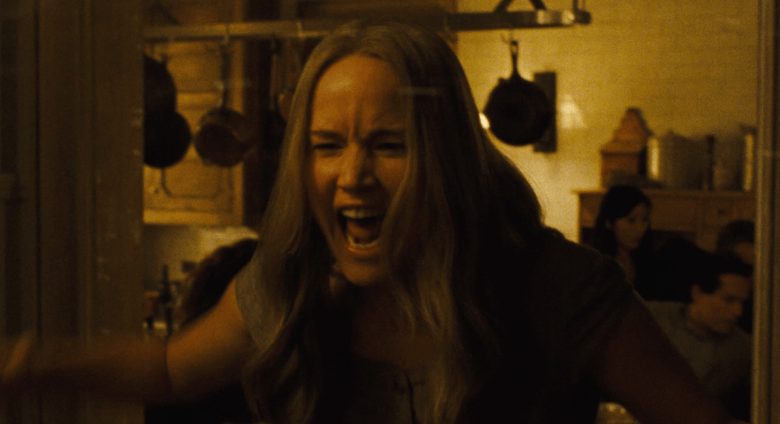
The only explanation for this strange kind of affair is a religious reference once again. If mother symbolizes Maria in this sequence, the narrative contains the new-testamentical birth of baby Jesus (Matthew 1). Written and visual proof for this hypothesis follow, as there are people bringing gifts (referring to Matthew 2:11) and Bardems character starts mumbling about the ‘beginning of something very special’. The climax is as intense as it should be: after a magnificent competition in staring and awkward eye-contact, Bardem takes away his son and give him to the people who are destined to do the most horrible thing. This is Gods offer to humanity, followed by Bardems completely inhuman urge to ‘forgive’ the people who just… well… if you saw mother!, and I hope you did at this point, you know what happened.
I will close this part of the discussion with one specific remark on the end credits. My statement is that Darren Aronofsky knew exactly what he was doing when he wrote his allegorical characters. Javier Bardems character doesn’t have an actual name until the end credits state he’s called ‘Him’ (note the capital H). About ten minutes earlier, the very same character proclaims the following line of dialogue: ‘I am who/that I am’. This line of dialogue corresponds with a biblical phrase in Exodus 3:14. When Mozes asks God on Mt. Sinaï what his name is, Gods answer equals the only direct clue Javier Bardem gives concerning his true identity. Furthermore, Brian Gleeson and Domhnal Gleeson (they are brothers in real life too) are listed as ’the younger brother’ and the ‘Oldest Son’ (imdb). All the guests visiting the house get characterizing titles to; there’s a Zealot (!), a cupbearer, a fool, a wanderer, even a Good Samaritan (Luke 10)… none of these characters has an actual name, but all the characters have a methaphorical one.
The house
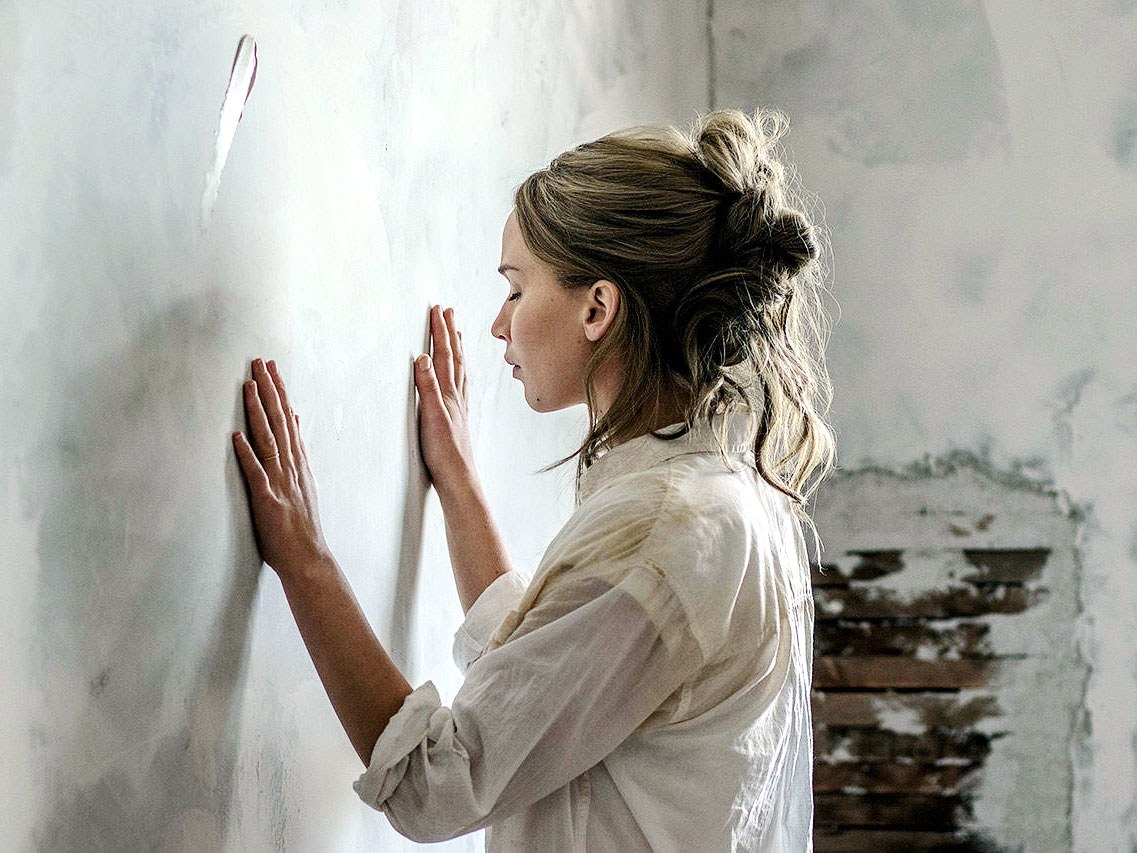
As you can see in soome of the more surrealistic shots of this movie, the house seems to have a heart. In my opinion, the house represents planet earth. God is the owner of the house, while mother! (Lawrence) is the protector of the house, the protector of life. Note how mother tries to restore everything in the house that’s broken or destroyed.
We ourselves are the unwanted guests that populate planet earth. We think we can afford to do anything, because the owner of the planet told us we could(ór we decide by ourselves we can). When Lawrences character asks the people in the house why they destroy everything and why they act as if the house is theirs, the guests all give the same answer: because the owner lets them, because he wants them to share everything. You can detect some serious criticism of religion here: I read these dialogues as a protest to the claim (of many believers) that anything is possible, just because God’s on their side.
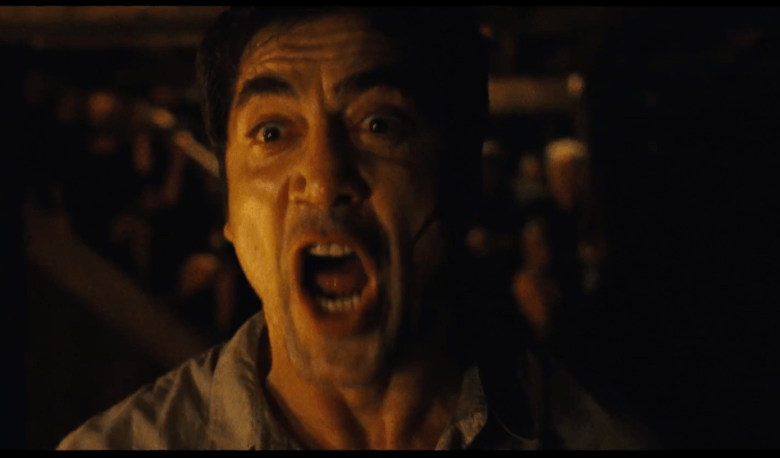
This is not a movie about truth or falsehood. It’s not about the question of Gods existence. Maybe it’s about the Death of God (yes, Bardem dies), but only on short notice; when the house is destroyed, the process of creation can begin again.
The ending of mother! thus brings Aronofsky’s last movie Noah back in the picture. After the flood (the end of the house/world an all the people on it), God has the surreal possibility to start all over again.
Conclusion
It’s important to emphasize that mother! Is open to many readings. My interpretation isn’t final at all, but I sincerely hope I have convinced you it is possible to interpret mother! The way I did. For me, the possibility of a (nearly perfect) religious allegory absolutely enriched this movie. It made me think about the screenplay in a completely different manner, and it enabled me to make sense of sequences that I probably wouldn’t understand if I hadn’t seen the clues I described in this essay.
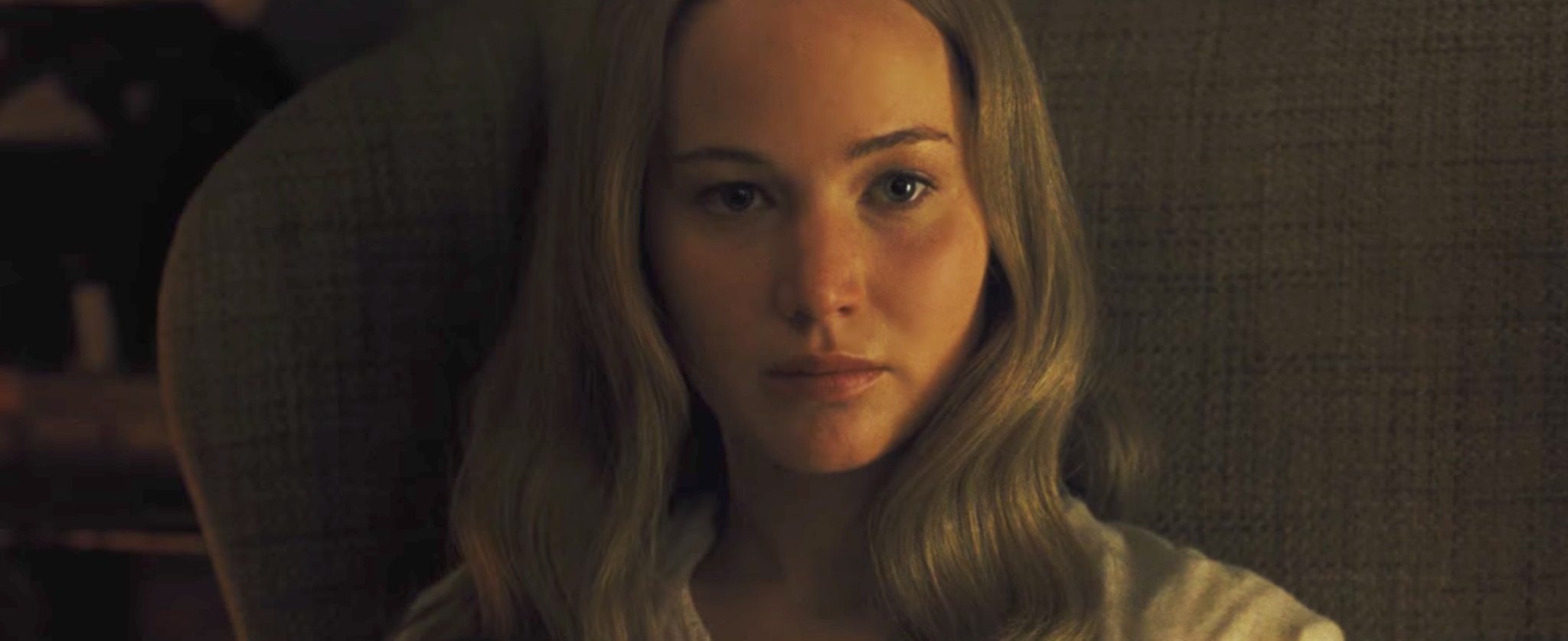
mother! is out in cinemas worldwide
Info: mother! (2017)/121 minutes/Genre: horror, drama, thriller, mystery/Director: Darren Aronofsky/Cast: Jennifer Lawrence, Javier Bardem, Ed Harris among others
[usr 5][:en]
Last tuesday I went to the theater to watch Darren Aronofsky’s mother! again. For those who wonder: nobody forced me to do that. I chose to feel uncomfortable for two more hours, to delve myself deeper into a story that got its hold on me all week long. This is a cinematic nightmare that will divide people for the years to come. It already does: mother! received an F-rating from the American cinema public, but there are many voices proclaiming the very same movie is an absolute masterpiece.
In this analytical essay, I will focus on one specific reading of this movie, that could possibly help to appreciate and understand some of the parts that put this psychological mystery together. In order to do that, I will use the proposotion that mother! can be read as an allegory. This means the ideas and the characters of the movie represent something else. They refer to meaningful concepts and stories that exceed the storyworld itself. The possibility of an allegory brings me to the following statement: Darren Aronofsky’s mother! Is an intriguing religious allegory, in which specific sequences and characters mainly refer to biblical stories, persons and ideas.
The characters

When the movie approached its shocking finale, it became clear to me that the male lead actually represents God. In the very beginning of the film, we see how the concept of creation goes hand in hand with the deeds of Javier Bardems character. After he touches a mysterious glowing stone, the house actually starts to ‘live’. Green vegetation replaces the dust, the darkness and the silence. The house thus awakens, and so does the character called mother (Jennifer Lawrence). The temporality here (creation and awakening go together) is the first clue mother is actually mother earth, or mother nature. I will come back to that observation later.
When you read the biblical book of Genesis, you can notice that the beginning of mother! resembles the process of biblical creation. Both stories elaborate on the possibility of making something out of nothing, using the performative power of a mighty entity. One interesting difference is at stake here: in Genesis, the voice of God is enough to start the process of creation (Genesis 1); in mother!, Javier Bardem needs a mystical stone to bring life into the house. This can be seen as a limitation; the God of mother! needs something else to create, he can’t do it all by himself. This suggestion becomes more solid if you keep in mind that Bardems character turns out to be a poet with a serious writers block. The principle of first creation is followed by hesitation and doubt. What to do, for example, when the people wandering on earth try to kill eachother?

In my opinion, the case for the story of Cain and Abel (Genesis 4) is really strong here. The two sons entering the house are the sons of the first people on earth, Adam and Eve (Ed Harris and Michelle Pfeiffer). We hear a testament prejudiced the younger brother (Brian Gleeson), causing the other son (Domhnal Gleeson) to kill him out of hate and jealousy. It’s also possible to see some reflections of the Jacob & Esau-story (>Genesis 25) here, as that story contains the specific element of heritage and prejudice, granted by the father (Isaak in Genesis, Adam in this story). My interpretation is that Darren Aronofsky is combining the stories of Cain & Abel and Jacob & Ezau. The narrative purpose of these references is purely suggestive: in mother!, conflicts are not caused by an evil entity (there is no snake, no devil), but by the very people God created. Evil resides in their nature, in their urge to revolt when (subjective forms of) injustice occur.
There is one character that represents real justice in this movie. The paradox of mother! is that this character isn’t God. It’s mother. When the movie is about halfway and all people (all but ‘God’ and mother) have left the house, mother confronts God with the fact that he doesn’t want to make love to her. There is much more ambiguity in this question than what meets the eye; if Bardems character actually IS God, it would make sense he isn’t interested in love-making. We have to take into account though that God ‘became’ a man of flesh and blood too; at least, if we continue thinking in christian characters, ideas and metaphors. In that case, a ‘higher’, metaphysical entity can actually have sexual desires. Another uncomfortable paradox… and you can definetely feel that discomfort in the painful scenes Bardem and Lawrence share.
God and mother do make love together, and this deed is followed by the strangest cinematic pregnancy I have witnessed in years. When mother wakes up the next morning, she just ‘knows’ she is pregnant. Her belly starts to grow, and everyone who watches this movie will confirm it doesn’t take nine months to give birth this time…

The only explanation for this strange kind of affair is a religious reference once again. If mother symbolizes Maria in this sequence, the narrative contains the new-testamentical birth of baby Jesus (Matthew 1). Written and visual proof for this hypothesis follow, as there are people bringing gifts (referring to Matthew 2:11) and Bardems character starts mumbling about the ‘beginning of something very special’. The climax is as intense as it should be: after a magnificent competition in staring and awkward eye-contact, Bardem takes away his son and give him to the people who are destined to do the most horrible thing. This is Gods offer to humanity, followed by Bardems completely inhuman urge to ‘forgive’ the people who just… well… if you saw mother!, and I hope you did at this point, you know what happened.
I will close this part of the discussion with one specific remark on the end credits. My statement is that Darren Aronofsky knew exactly what he was doing when he wrote his allegorical characters. Javier Bardems character doesn’t have an actual name until the end credits state he’s called ‘Him’ (note the capital H). About ten minutes earlier, the very same character proclaims the following line of dialogue: ‘I am who/that I am’. This line of dialogue corresponds with a biblical phrase in Exodus 3:14. When Mozes asks God on Mt. Sinaï what his name is, Gods answer equals the only direct clue Javier Bardem gives concerning his true identity. Furthermore, Brian Gleeson and Domhnal Gleeson (they are brothers in real life too) are listed as ’the younger brother’ and the ‘Oldest Son’ (imdb). All the guests visiting the house get characterizing titles to; there’s a Zealot (!), a cupbearer, a fool, a wanderer, even a Good Samaritan (Luke 10)… none of these characters has an actual name, but all the characters have a methaphorical one.
The house

As you can see in soome of the more surrealistic shots of this movie, the house seems to have a heart. In my opinion, the house represents planet earth. God is the owner of the house, while mother! (Lawrence) is the protector of the house, the protector of life. Note how mother tries to restore everything in the house that’s broken or destroyed.
We ourselves are the unwanted guests that populate planet earth. We think we can afford to do anything, because the owner of the planet told us we could(ór we decide by ourselves we can). When Lawrences character asks the people in the house why they destroy everything and why they act as if the house is theirs, the guests all give the same answer: because the owner lets them, because he wants them to share everything. You can detect some serious criticism of religion here: I read these dialogues as a protest to the claim (of many believers) that anything is possible, just because God’s on their side.

This is not a movie about truth or falsehood. It’s not about the question of Gods existence. Maybe it’s about the Death of God (yes, Bardem dies), but only on short notice; when the house is destroyed, the process of creation can begin again.
The ending of mother! thus brings Aronofsky’s last movie Noah back in the picture. After the flood (the end of the house/world an all the people on it), God has the surreal possibility to start all over again.
Conclusion
It’s important to emphasize that mother! Is open to many readings. My interpretation isn’t final at all, but I sincerely hope I have convinced you it is possible to interpret mother! The way I did. For me, the possibility of a (nearly perfect) religious allegory absolutely enriched this movie. It made me think about the screenplay in a completely different manner, and it enabled me to make sense of sequences that I probably wouldn’t understand if I hadn’t seen the clues I described in this essay.

mother! is out in cinemas worldwide
Info: mother! (2017)/121 minutes/Genre: horror, drama, thriller, mystery/Director: Darren Aronofsky/Cast: Jennifer Lawrence, Javier Bardem, Ed Harris among others
[usr 5][:]
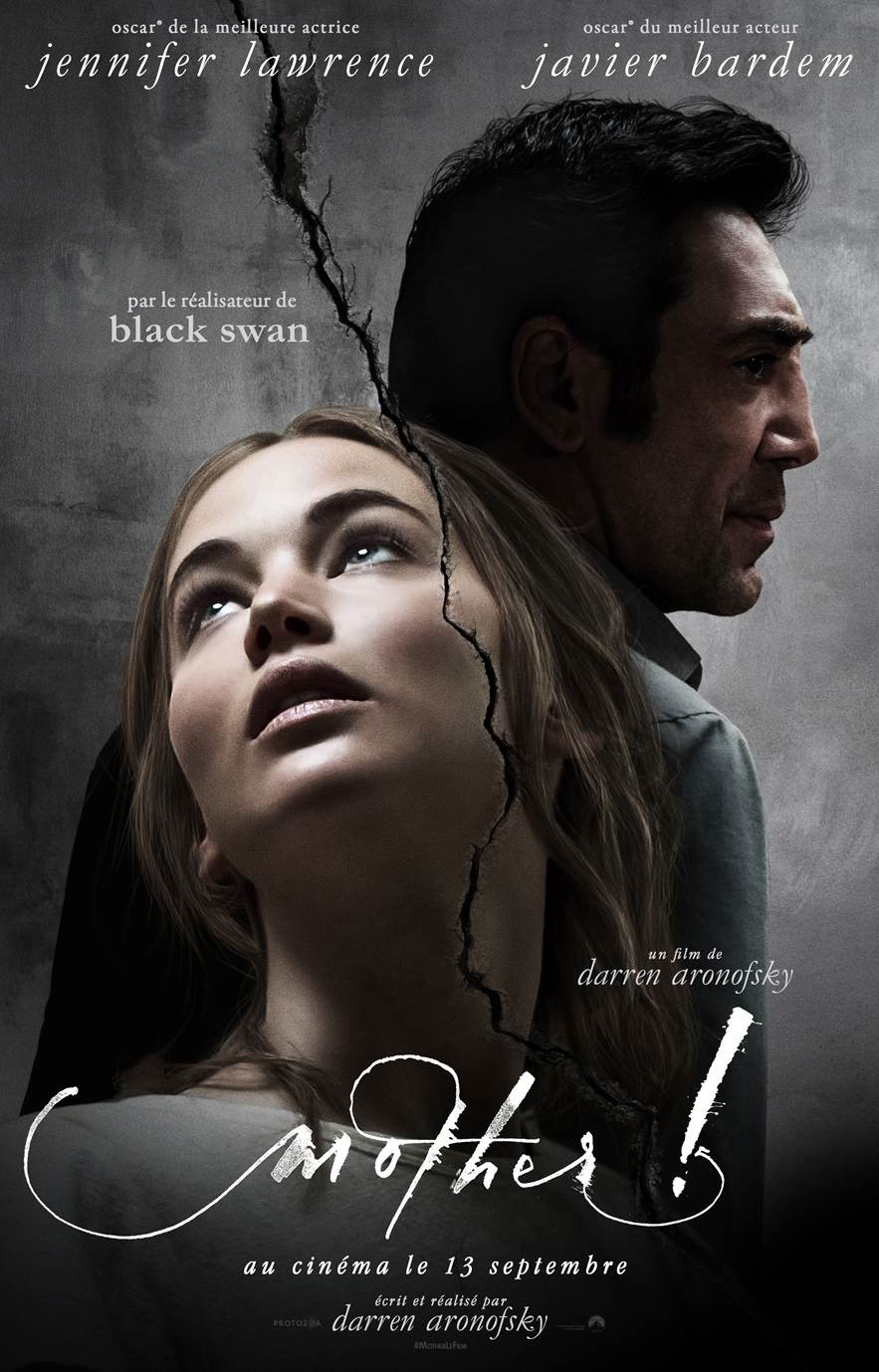

Saw this movie last tuesday without reading any critics and spoilers. I made the same conclusions you did. The killing of the brother was what triggered me to watch it from a biblical perspectif from there on as I saw the story of Caïn and Abel in it. Interpreted Pfeiffer and Harris as Adam and Eve, but missed out on the creation from a rib.
Some parts that I’m missing in most reviews are the following:
Nailing the room down after the glass heart breaks is obviously the banning of Adam and Eve from the garden of Eden.
What’s the story behind the Bloodstain? I think it symbolizes innocence is lost and it polutes the Earth. It also finds it’s way to the core of the earth (the basement) leaving a gap (mining of minerals destroying the surface) and finding it’s way to the darkest part of earth; it’s oilreserves) This is what ultimately kills everything at the end of the movie.
The brother tore apart the image of Him and drew on it, making him look like the devil (god and devil are the same)
The bloodstain is one of the aspects that was too ambigious, too mysterious for me to place it into a bigger framework (here: reading mother! as a religious allegory). It could have something to do with guilt and innocence (indeed), but in that case I would have liked to see a clear(er) connection with the (guilty) people causing the house to bleed.
We see this bloodstain long before the house gets populated with all these symbolic characters, so I’m wondering if i’m missing something…
Furthermore, I would like to react on this comment: ‘Nailing the room down after the glass heart breaks is obviously the banning of Adam and Eve from the garden of Eden’.
-> I think you’re right, thanks for this complement. The very moment Pfeiffer enters the room and takes the mystical stone symbolizes the story of the forbidden fruit/apple.
‘The brother tore apart the image of Him and drew on it, making him look like the devil (god and devil are the same)’
-> this would add some extra weight to the argument that mother! is a real piece of religious criticism too. For myself, I didn’t see/note any representation of the devil while watching, I just thought God was represented as being evil (but then without being the devil at the same time). I think I would have to watch the movie again to possibly change my mind.
I still don’t know what to think of this movie!
Take your time:)
The bloodstain could mean the birth of sin into the world. Also I would like to add that Adam (male character / Ed Harris) is missing a rib after walking with God. Short thereafter Eve appears.
The crystal is synonymous for the forbidden fruit and the woman tells the people to don’t touch it. After the people touch it, they arent allowed to enter the room anymore.
And so on.. And so on..
Masterpiece!
Thanks for your comments! I absolutely agree with the suggestion that the crystal symbolizes the apple/forbidden fruit. Also note my last comment above.
The arrival of Eve and the mysterious wound Adam has in the movie completely fit into the narrative of Genesis. My guess is you’re absolutely right here too:)
Hahaha, ik ga even voor het Nederlands. Maar inderdaad, alles wat je zegt had ik ook door tijdens het zien van die film. Het was best wel voor de hand liggend. Inderdaad ook die rib en die kristal als verboden vrucht. Alleen na de begravenis van Abel (Kaïn en Abel) spoot die waterleiding. Dat was zegmaar de zondvloed. Na de vloed begon alles overnieuw en kwamen er toch steeds meer mensen en uiteindelijk volgt de film niet meer de bijbel en vernietigt moeder aarde het huis. Dat is dan de apocalyps.
Maar leuke symboliek in de film, maar ik vond het net geen meesterwerk. Een 8, dat wel. Maar ik mist een bepaalde emotie en zo.
Haha, prima hoor.
Voor de hand liggend is het zeker voor een groot deel, al moet je de Bijbelse personages en verhalen waar de film naar verwijst natuurlijk wel (goed) kennen. Lang niet iedereen doet dat. Daarnaast blijven er nog veel elementen open voor interpretatie. Dat de twee broers Kaïn en Abel representeren spreekt haast voor zich, maar wat te denken van het bloedende huis? etc etc
Dat van die waterleiding had ik niet opgemerkt, thanks voor de aanvulling. Of Aronofsky echt atheïst is weet ik niet. Heb het ‘em nooit horen zeggen, en religiekritiek staat niet altijd gelijk aan atheïsme.
Emotie miste ik zelf niet. Lawrence vond ik heel intens acteren, en dan in combi met het camerawerk… scheelt als je in de bios erg dicht op het scherm zit.
De waterleiding was mij ook opgevallen en ik merk dat de film heel erg uit twee gedeelten bestaat. De man des huizes laat tot tweemaal toe anderen in huis (twee verbonden OT/NT).
Ter toevoeging op de reactie boven mij: ik vind Aranofsky felle kritiek uiten maar zie in deze film geen overwegend atheïsme terug.
En het is echt zeer duidelijk dat Arofnosky atheïst is, laat ik dat toevoegen.
Recent eindelijk gezien (wilde ‘m toch nog voor het einde van het jaar gezien hebben om ‘m voor m’n top 10 mogelijk mee te kunnen nemen) en wist totaal niet wat ik van tevoren kon verwachten. Wist dat het filmgaand publiek extreem verdeeld was, maar snap nu helemaal waarom. Eerste deel kreeg ik zelf een heel sterk Black Swan gevoel bij en pas in het tweede deel begonnen de religieuze symboliek me pas op te vallen, echter lang niet zo sterk als bijvoorbeeld bij jou. Nu dit gelezen te hebben kan ik me daar wel helemaal in vinden.
Wat denk je dat datgene wat hij uiteindelijk schrijft is? Is dit de bijbel aangezien gezegd wordt dat de tekst voor iedereen iets anders kan betekenen?
Het was wel een zware film om te kijken, want had niet verwacht dat dit allemaal zou gebeuren, maar vond het wel een erg goede film.
Je reactie was gek genoeg in de spam terecht gekomen – nu goed, ik heb ‘em er gelukkig snel uit kunnen vissen.
Ik denk persoonlijk dat Aronofsky heel goed weet wat ‘ie doet, en dat meer dan driekwart van de religieuze symboliek die je erin kan herkennen welbewust in de film is gestopt. Neemt niet weg, en dat vind ik direct ook zo mooi, dat je de film óók op allerlei andere manieren kunt lezen. Puur psychologisch, of focussen op de ‘klimaatlezing’ (de verwaarlozing van het huis=de verwaarlozing van onze planeet). Je kunt deze film goed vinden zonder je ook maar één keer om alle (religieuze) metaforen te bekommeren.
Ik snap dat je ‘em zwaar vond, logisch; kun je nagaan hoe dat was in de bioscoop:) Zelf had ik twee kijkbeurten nodig, en nog steeds hebben niet alle elementen helemaal hun plekje gekregen.